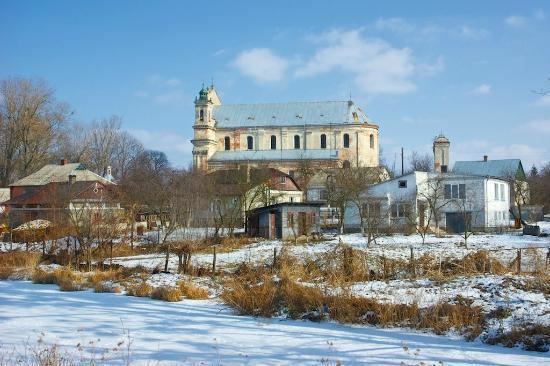Magdeburg law 1564 Area 4.91 km² Local time Friday 9:43 AM | The first mention 1149 Time zone EET (UTC+2) Population 3,130 (2015) | |
 | ||
Weather 8°C, Wind W at 18 km/h, 92% Humidity | ||
Olyka (Ukrainian: Олика, Polish: Ołyka, Yiddish: אליק Olik) is an urban-type settlement in Kivertsi Raion, Volyn Oblast, Ukraine. It is located east of Lutsk on the Putilovka Rriver. Population: 3,130 (2015 est.)
Contents
- Map of Olyka Volyn Oblast Ukraine
- History
- Notable landmarks
- Other Radziwill estates
- Jewish presence
- References
Map of Olyka, Volyn Oblast, Ukraine
History
The village of Olyka was founded in early Middle Ages as one of the villages belonging to the Kievan Rus'. It was first mentioned in 1149. In the 14th century it was conquered by Grand Duchy of Lithuania and in 1569, in the effect of the Union of Lublin became part of Poland.
In the Grand Duchy of Lithuania the village grew rapidly and became a centre of local magnates, initially the family of Kiška and after 1533 - the Radziwills. In second half of the 16th century the town became one of the most important centres of Calvinism in the Polish-Lithuanian Commonwealth. Its growth was halted by the Chmielnicki Uprising of 1648, during which the town was captured by Cossacks, plundered and burnt. However, it was soon rebuilt and in 1654 it received city rights. As the main seat of one of the branches of the influential Radziwill family, Olyka became one of the most important political and trade centres of whole Volhynia.
In the Third Partition of Poland (1795) the town was annexed by the Russian Empire and became part of the Volhynian Governorate. In the 19th century it continued to play its role as a centre of wood and grain trade. During World War I in 1915 and 1916 the area was a scene of heavy fighting between the forces of Russia and Austria-Hungary. After the Polish-Bolshevik War the town was restored to Poland as part of Wołyń Voivodeship and the local palace was refurbished. In the effect of the Polish Defensive War of 1939 and the Nazi-Soviet Alliance, the town was occupied by Soviet Union. After the Operation Barbarossa the German occupation started and lasted until 1944. After World War II the area was annexed by the Soviet Union and incorporated into the Ukrainian SSR. Since 1991 it is a part of independent Ukraine.
Notable landmarks
Other Radziwill estates
Jewish presence
Olyka had a large Jewish community that was all destroyed during the Holocaust, but is still an important place of Jewish memory. It was believed that the prayer by rabbi David HaLevi Segal miraculously saved the Jewish and non-Jewish citizens of Olyka from the Cossacks' assault of 1651.
Olyka was the cradle of the Olyker Haasidic dynasty that was founded by the famous Rabbi Hersh Leib Landa the first Olyker rebbe. He was followed by his son Rabbi Yoseph Dovid, who was followed by his son Rabbi Mordechai (he authored a book called Gedulas Mordechai), He was followed by his son Rabbi Shimon Shloima (he authored a book called Shekel Hakodesh), he was followed by his son Rabbi Alter Yoseph Dovid who perished together with his whole family during the Holocaust.
A modest monument commemorates the place of execution of more than 4,000 Jews in Summer 1942.
